Time-Series Evolution Patterns of Land Subsidence in the Eastern Beijing Plain, China
Abstract
:1. Introduction
2. Study Area and Dataset
2.1. Study Area
2.2. Dataset
3. Methods
3.1. PSI Method
3.2. Standard Deviation Ellipse Method
3.3. Permutation Entropy Method
4. Results
4.1. Land Subsidence Information Monitoring by PSI Validation
4.2. Spatial Evolution Pattern by the SDE Method
4.2.1. Changes in the land subsidence funnel area
4.2.2. Changes in the center of the gravity of land subsidence
4.2.3. Changes in the distribution range of land subsidence
4.2.4. Changes in the distribution of land subsidence
4.3. Temporal Evolution Pattern by the PE Method
5. Discussion
5.1. Relationship Between the Spatial Evolution Pattern by the SDE Method and Hydrogeologic Data
5.2. Relationship Between the Temporal Evolution Pattern by the PE Method and Groundwater
6. Conclusions
Author Contributions
Acknowledgments
Conflicts of Interest
References
- Wright, T.J.; Parsons, B.E.; Lu, Z. Toward mapping surface deformation in three dimensions using InSAR. Geophys. Res. Lett. 2004, 31, 169–178. [Google Scholar] [CrossRef]
- Lohman, R.B.; Simons, M. Some thoughts on the use of InSAR data to constrain models of surface deformation: Noise structure and data downsampling. Geochem. Geophys. Geosyst. 2013, 6. [Google Scholar] [CrossRef]
- Chaussard, E.; Wdowinski, S.; Cabral-Cano, E.; Amelung, F. Land subsidence in central Mexico detected by ALOS InSAR time-series. Remote Sens. Environ. 2014, 140, 94–106. [Google Scholar] [CrossRef]
- Eriksen, H.Ø.; Lauknes, T.R.; Larsen, Y.; Corner, G.D.; Bergh, S.G.; Dehls, J.; Kierulf, H.P. Visualizing and interpreting surface displacement patterns on unstable slopes using multi-geometry satellite SAR interferometry (2D InSAR). Remote Sens. Environ. 2017, 191, 297–312. [Google Scholar] [CrossRef]
- Ferretti, A.; Prati, C.; Rocca, F. Nonlinear subsidence rate estimation using permanent scatterers in differential SAR interferometry. IEEE Trans. Geosci. Remote Sens. 2000, 38, 2202–2212. [Google Scholar] [CrossRef]
- Ferretti, A.; Colesanti, C.; Prati, C.; Rocca, F. Radar permanent scatterers identification in urban areas: Target characterization and sub-pixel analysis. In Proceedings of the IEEE Remote Sensing and Data Fusion Over Urban Areas, IEEE/isprs Joint Workshop, Rome, Italy, 8–9 November 2001; p. 52. [Google Scholar]
- Gong, H.; Zhang, Y.; Li, X.; Lu, X.; Chen, B.; Gu, Z. Land subsidence research in Beijing based on the Permanent Scatterers InSAR technology. Prog. Nat. Sci. 2009, 19, 1261–1266. [Google Scholar]
- Ng, A.H.; Ge, L.; Li, X.; Abidin, H.Z.; Andreas, H.; Zhang, K. Mapping land subsidence in Jakarta, Indonesia using persistent scatterer interferometry (PSI) technique with ALOS PALSAR. Int. J. Appl. Earth Obs. Geoinf. 2012, 18, 232–242. [Google Scholar] [CrossRef]
- Chaussard, E.; Amelung, F.; Abidin, H.; Hong, S.H. Sinking cities in Indonesia: ALOS PALSAR detects rapid subsidence due to groundwater and gas extraction. Remote Sens. Environ. 2013, 128, 150–161. [Google Scholar] [CrossRef]
- Raspini, F.; Loupasakis, C.; Rozos, D.; Adam, N.; Moretti, S. Ground subsidence phenomena in the Delta municipality region (Northern Greece): Geotechnical modeling and validation with Persistent Scatterer Interferometry. Int. J. Appl. Earth Obs. Geoinf. 2014, 28, 78–89. [Google Scholar] [CrossRef] [Green Version]
- Salvi, S.; Atzori, S.; Tolomei, C.; Antonioli, A.; Trasatti, E.; Merryman Boncori, J.P.; Pezzo, G.; Coletta, A.; Zoffoli, S. Results from INSAR monitoring of the 2010–2011 New Zealand seismic sequence: EA detection and earthquake triggering. In Proceedings of the IEEE International Geoscience and Remote Sensing Symposium, Munich, Germany, 22–27 July 2012; pp. 3544–3547. [Google Scholar]
- Champenois, J.; Fruneau, B.; Pathier, E.; Deffontaines, B.; Lin, K.-C.; Hu, J.-C. Monitoring of active tectonic deformations in the Longitudinal Valley (eastern Taiwan) using Persistent Scatterer InSAR method with ALOS PALSAR data. Earth Planet. Sci. Lett. 2012, 337, 144–155. [Google Scholar] [CrossRef]
- Krishnan, S.P.V.; Kim, D.; Jung, J. Subsidence in the Kathmandu Basin, before and after the 2015 Mw 7.8 Gorkha Earthquake, Nepal Revealed from Small Baseline Subset-DInSAR Analysis. GISci. Remote Sens. 2018, 55, 604–621. [Google Scholar]
- Farina, P.; Colombo, D.; Fumagalli, A.; Marks, F.; Moretti, S. Permanent Scatterers for landslide investigations: Outcomes from the ESASLAM project. Eng. Geol. 2006, 88, 200–217. [Google Scholar] [CrossRef]
- Mikhailov, V.; Kiseleva, E.; Smolyaninova, E.; Golubev, V.; Dmitriev, P.; Isaev, Y.; Dorokhin, K.; Hooper, A.; Esfahany, S.; Hanssen, R.; Khairetdinov, S. PS-InSAR Monitoring of Landslides in The Great Caucasus, Russia, Using Envisat, ALOS And TerraSAR-X SAR Images. In Proceedings of the ESA Living Planet Symposium, Edinburgh, United Kingdom, 9–13 September 2013; p. 283. [Google Scholar]
- Kiseleva, E.; Mikhailov, V.; Smolyaninova, E.; Dmitriev, P.; Golubev, V.; Timoshkina, E.; Hooper, A.; Samiei-Esfahany, S.; Hanssen, R. PS-InSAR Monitoring of Landslide Activity in the Black Sea Coast of the Caucasus. Procedia Technol. 2014, 16, 404–413. [Google Scholar] [CrossRef] [Green Version]
- Zhu, L.; Gong, H.; Li, X.; Wang, R.; Chen, B.; Dai, Z.; Teatini, P. Land subsidence due to groundwater withdrawal in the northern Beijing plain, China. Eng. Geol. 2015, 193, 243–255. [Google Scholar] [CrossRef]
- Chen, B.; Gong, H.; Li, X.; Lei, K.; Gao, M.; Zhou, C.; Ke, Y. Spatial–temporal evolution patterns of land subsidence with different situation of space utilization. Nat. Hazards 2015, 77, 1765–1783. [Google Scholar] [CrossRef]
- Chen, M.; Tomás, R.; Li, Z.; Motagh, M.; Li, T.; Hu, L.; Gong, H.; Li, X.; Yu, J.; Gong, X. Imaging Land Subsidence Induced by Groundwater Extraction in Beijing (China) Using Satellite Radar Interferometry. Remote Sens. 2016, 8, 468. [Google Scholar] [CrossRef]
- Zhang, Y.; Wu, H.A.; Kang, Y.; Zhu, C. Ground Subsidence in the Beijing-Tianjin-Hebei Region from 1992 to 2014 Revealed by Multiple SAR Stacks. Remote Sens. 2016, 8, 675. [Google Scholar] [CrossRef]
- Zhou, C.; Gong, H.; Zhang, Y.; Warner, T.; Wang, C. Spatiotemporal Evolution of Land Subsidence in the Beijing Plain 2003–2015 Using Persistent Scatterer Interferometry (PSI) with Multi-Source SAR Data. Remote Sens. 2018, 10, 552. [Google Scholar] [CrossRef]
- Zhou, C.; Gong, H.; Chen, B.; Guo, L.; Gao, M.; Chen, W.; Liang, Y.; Si, Y.; Wang, J.; Zhang, X. Spatiotemporal characteristics of land subsidence in Beijing from small baseline subset interferometric synthetic aperture radar and standard deviational ellipse. In Proceedings of the International Workshop on Earth Observation and Remote Sensing Applications, Guangzhou, China, 4–6 July 2016; pp. 78–82. [Google Scholar]
- Chen, B.; Gong, H.; Li, X.; Lei, K.; Zhu, L.; Gao, M.; Zhou, C. Characterization and causes of land subsidence in Beijing, China. Int. J. Remote Sens. 2017, 38, 808–826. [Google Scholar] [CrossRef]
- Yang, Q.; Ke, Y.; Zhang, D.; Chen, B.; Gong, H.; Lv, M.; Zhu, L.; Li, X. Multi-Scale Analysis of the Relationship between Land Subsidence and Buildings: A Case Study in an Eastern Beijing Urban Area Using the PS-InSAR Technique. Remote Sens. 2018, 10, 1006. [Google Scholar] [CrossRef]
- Bandt, C.; Pompe, B. Permutation entropy: A natural complexity measure for time series. Phys. Rev. Lett. 2002, 88, 1–4. [Google Scholar] [CrossRef] [PubMed]
- Feng, F.Z.; Rao, G.Q.; Si, A.W.; Sun, Y. Application and Development of Permutation Entropy Algorithm. J. Acad. Armored Force Eng. 2012, 02, 34–38. [Google Scholar] [CrossRef]
- Liu, J.; Zhang, C.; Zheng, C.; Yu, X. Mental fatigue analysis based on complexity measure of multichannel electroencephalogram. J. Xian Jiaotong Univ. 2008, 42, 1555–1559. [Google Scholar]
- Soriano, M.C.; Zunino, L.; Larger, L.; Fischer, I.; Mirasso, C.R. Distinguishing fingerprints of hyperchaotic and stochastic dynamics in optical chaos from a delayed opto-electronic oscillator. Opt. Lett. 2011, 36, 2212–2214. [Google Scholar] [CrossRef] [PubMed]
- Veisi, I.; Pariz, N.; Karimpour, A. Fast and Robust Detection of Epilepsy in Noisy EEG Signals Using Permutation Entropy. In Proceedings of the IEEE International Conference on Bioinformatics and Bioengineering, Boston, MA, USA, 14–17 October 2007; pp. 200–203. [Google Scholar]
- Wang, L. A universal algorithm to generate pseudo-random numbers based on uniform mapping as homeomorphism. Chin. Phys. B 2010, 19, 090505. [Google Scholar]
- Beijing Water Resources Bureau; Beijing Water Resources Bulletin: Beijing, China, 2017.
- Lefever, D.W. Measuring geographic concentration by means of the stand deviational ellipse. Am. J. Sociol. 1926, 31, 88–94. [Google Scholar] [CrossRef]
- Lei, K.; Luo, Y.; Chen, B.; Guo, G.; Zhou, Y. Distribution characteristics and influence factors of land subsidence in Beijing area. Geol. China 2016, 43, 2216–2228. [Google Scholar]
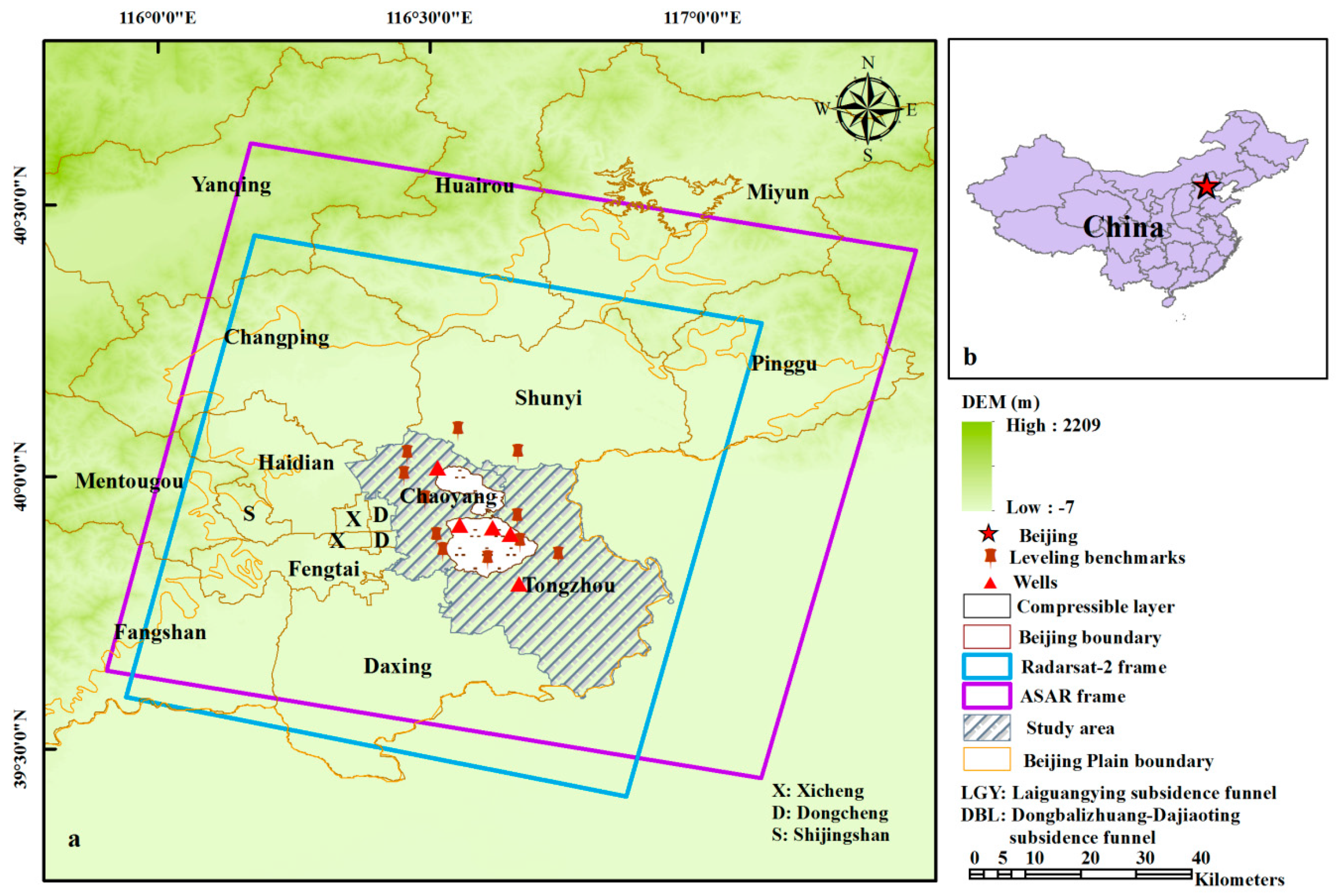
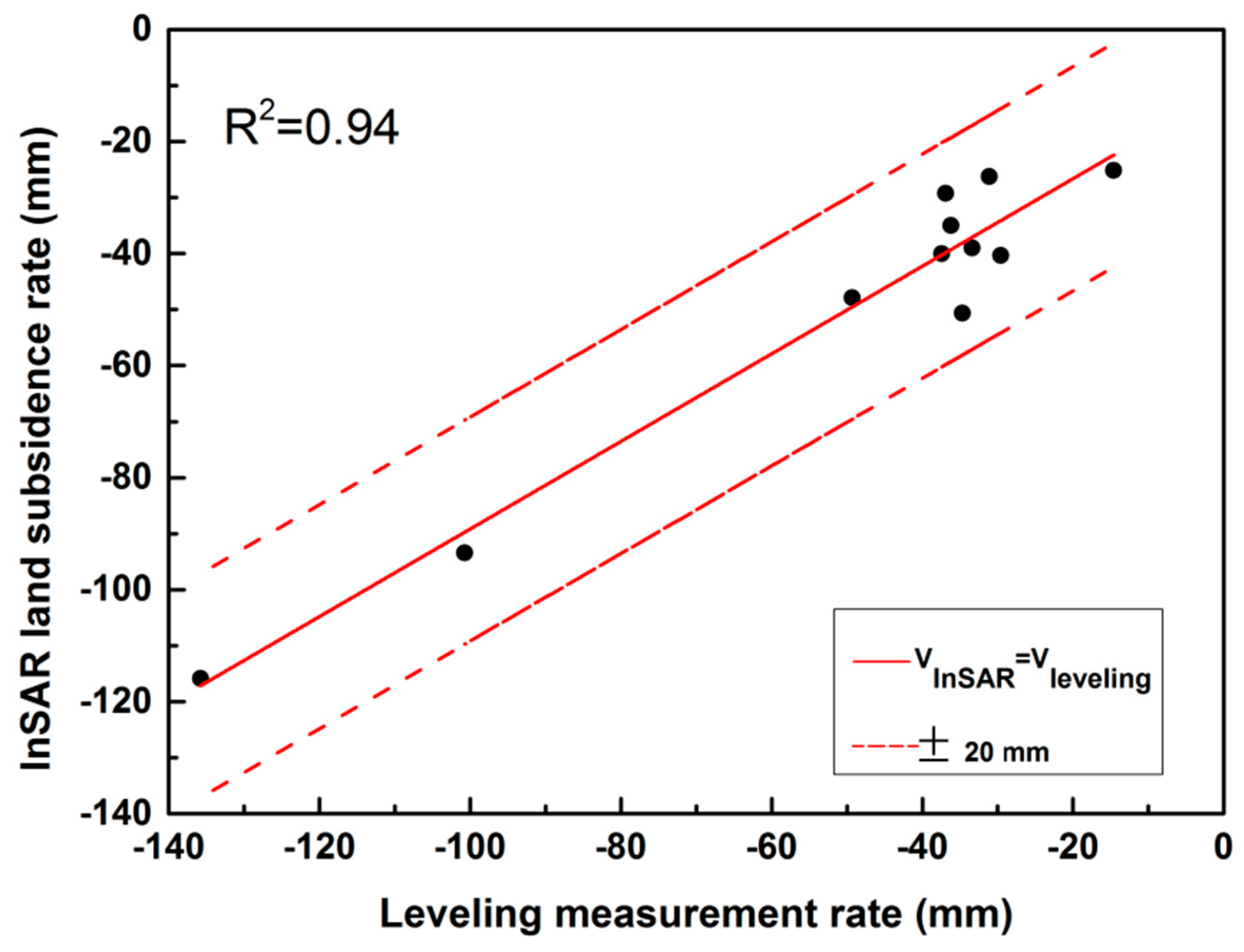
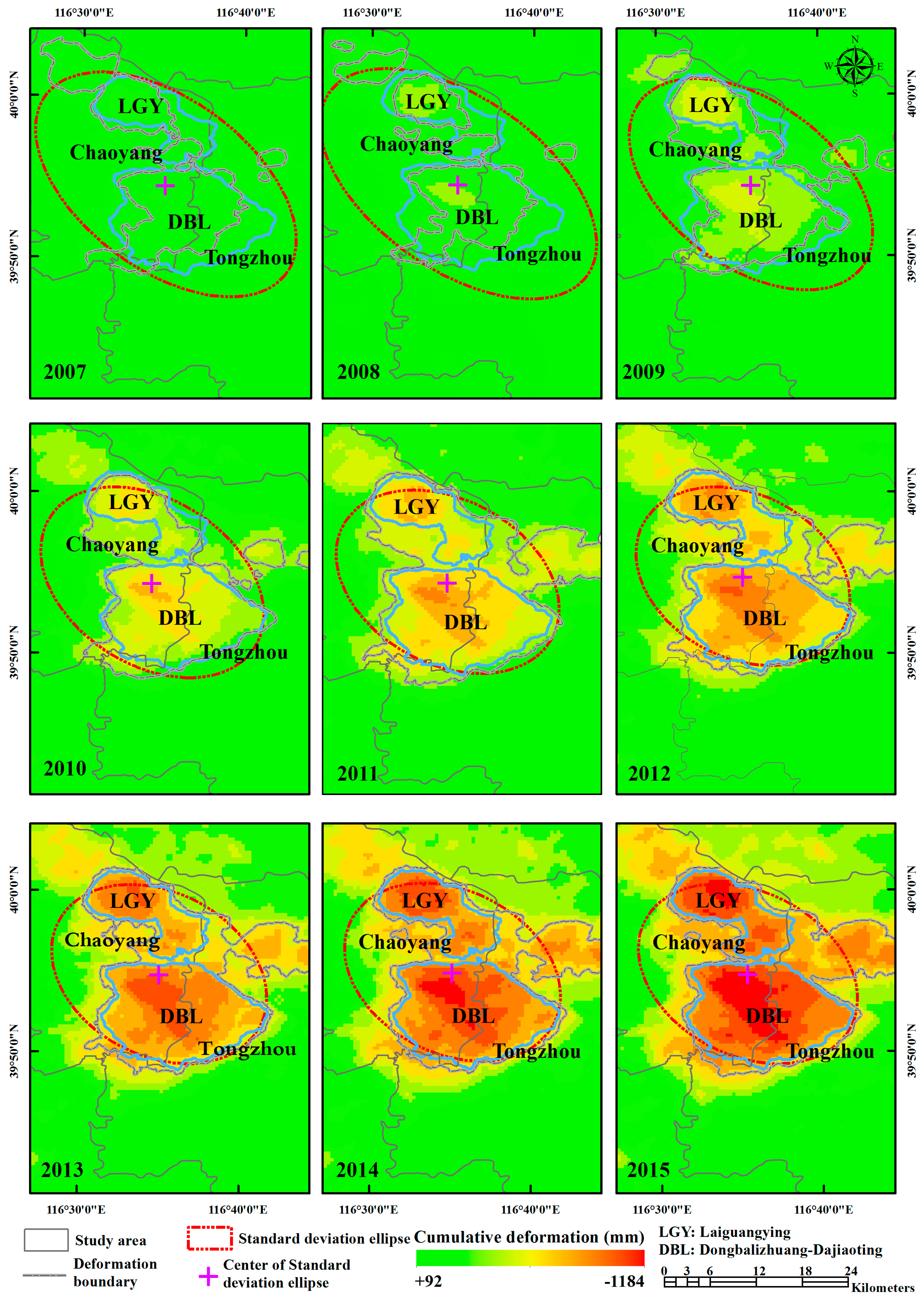

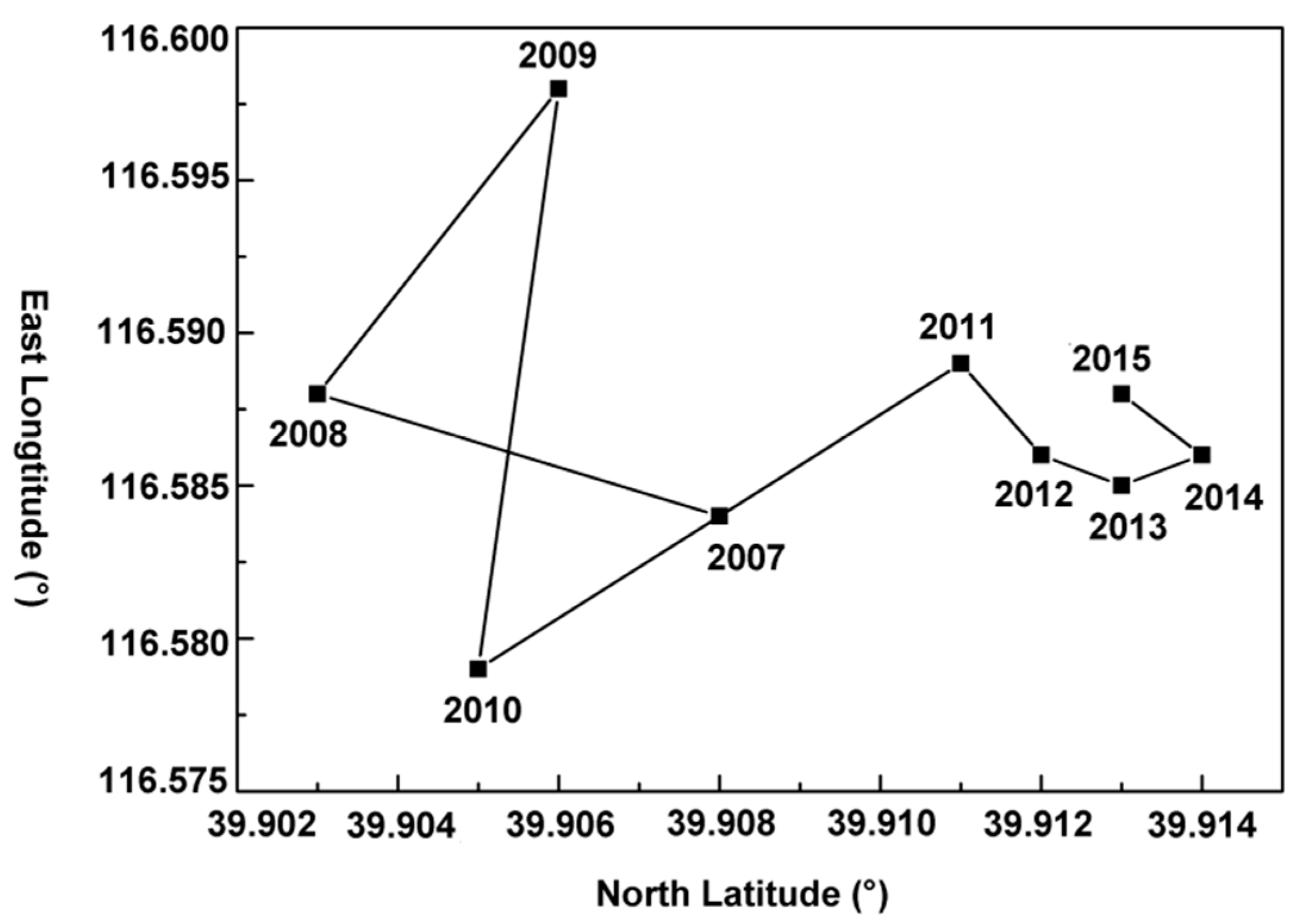
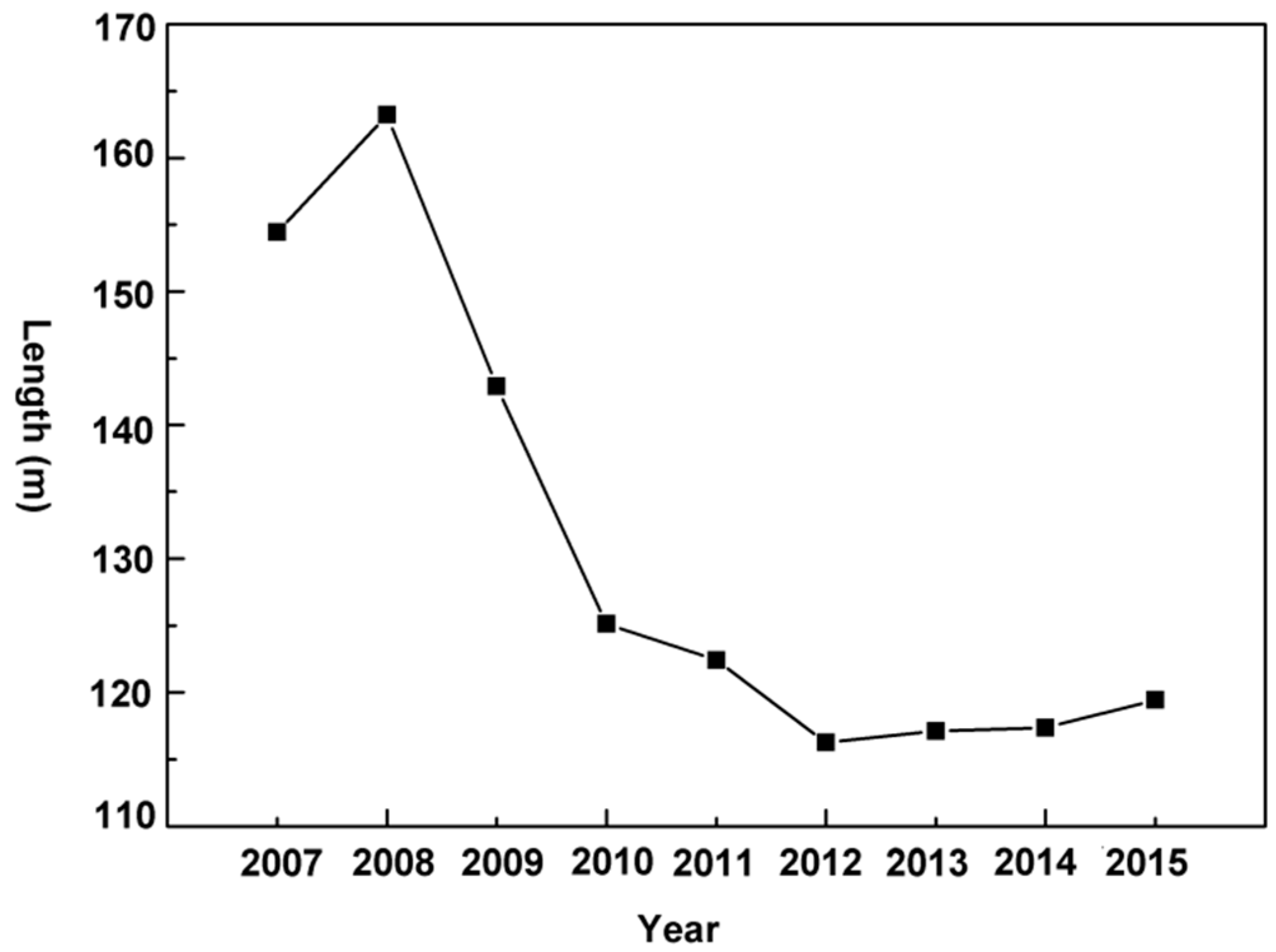
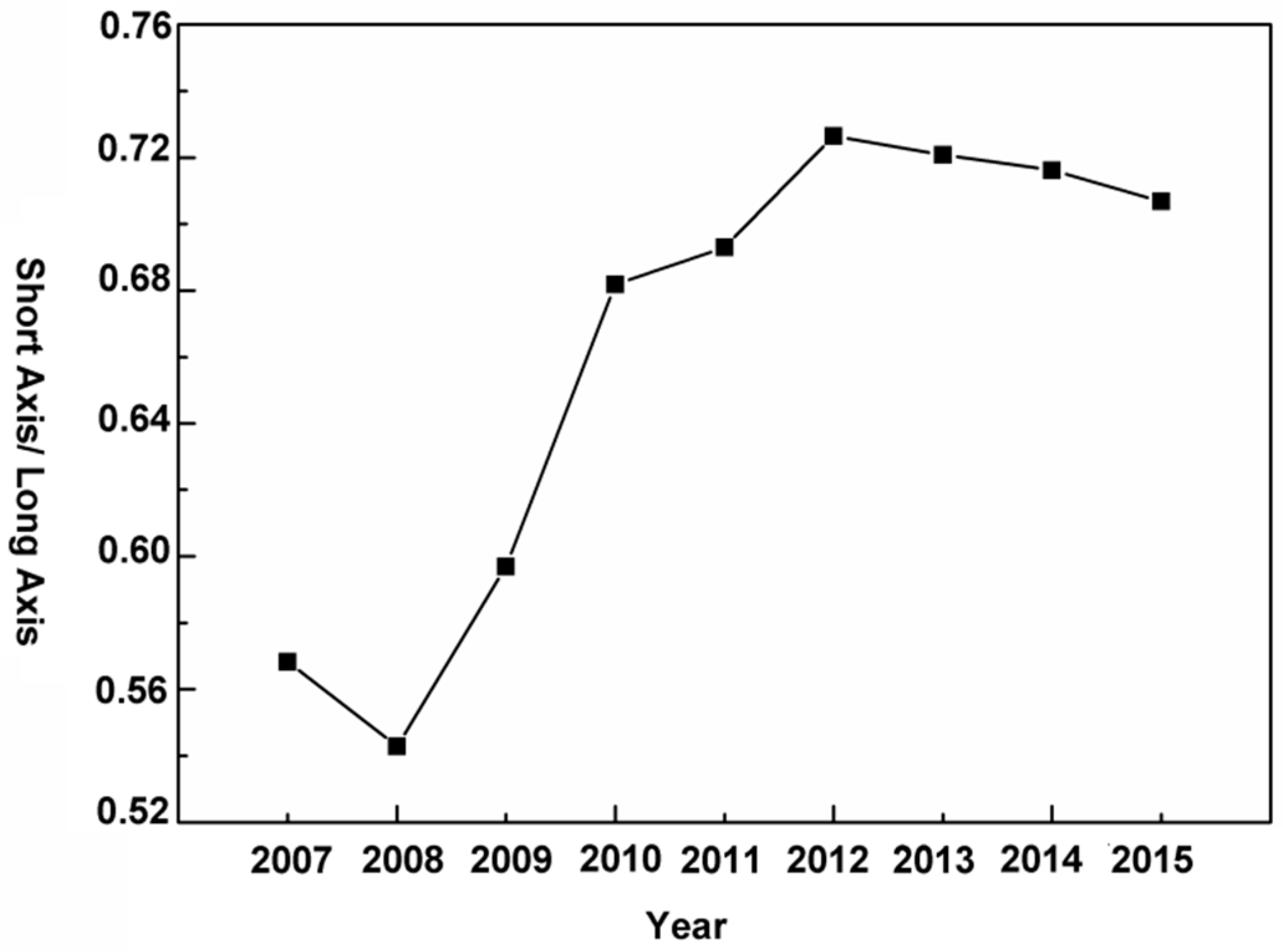
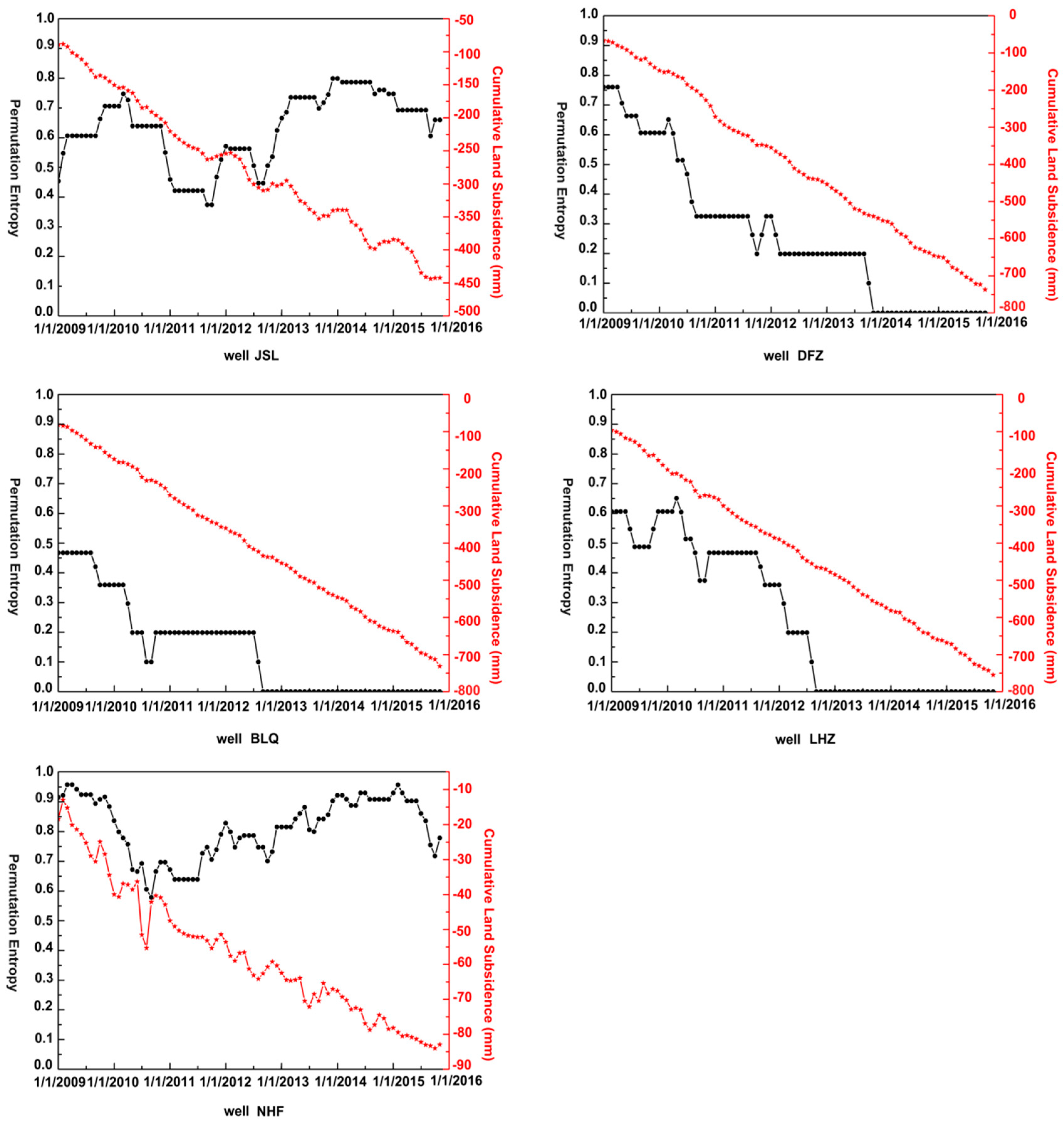
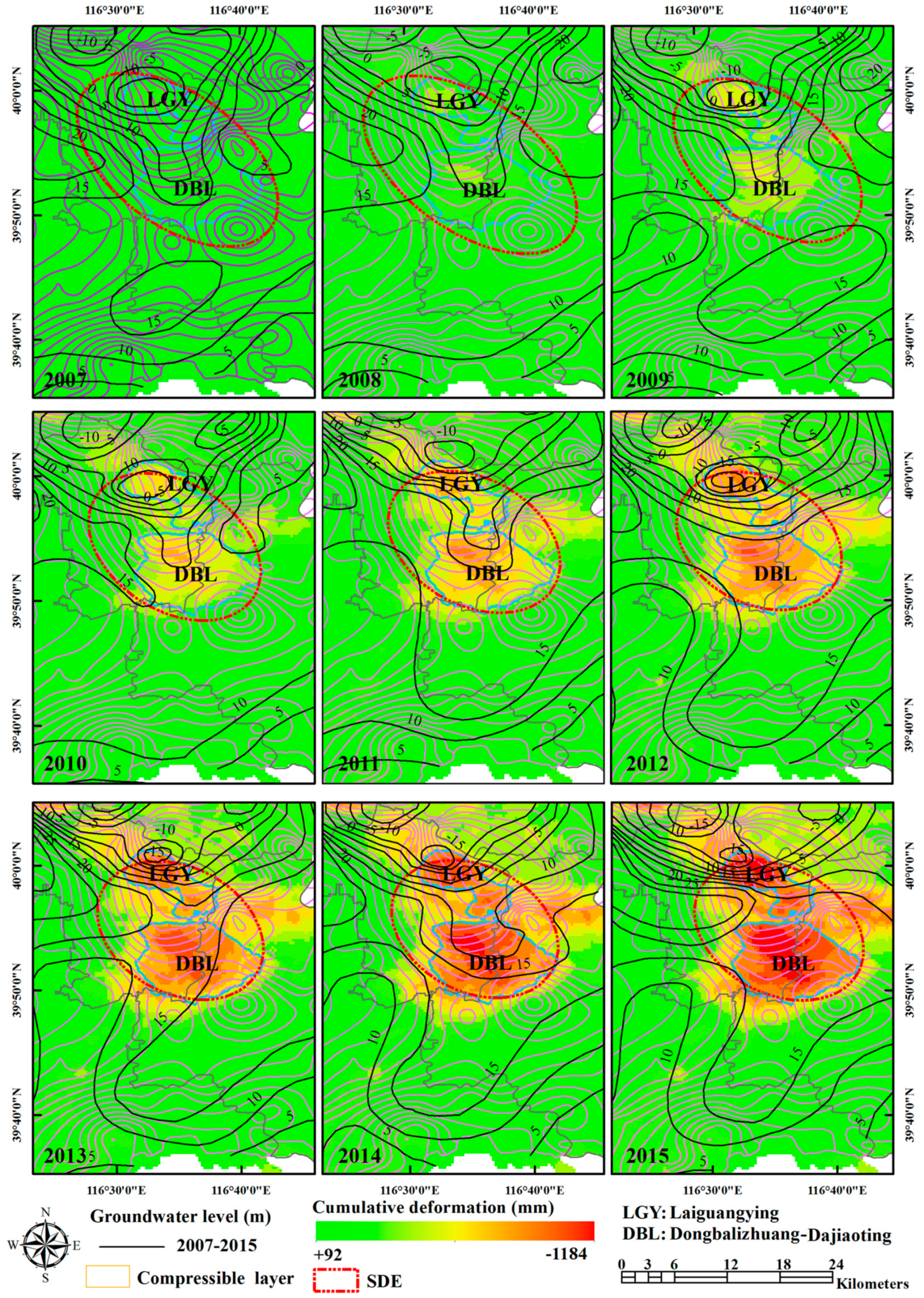

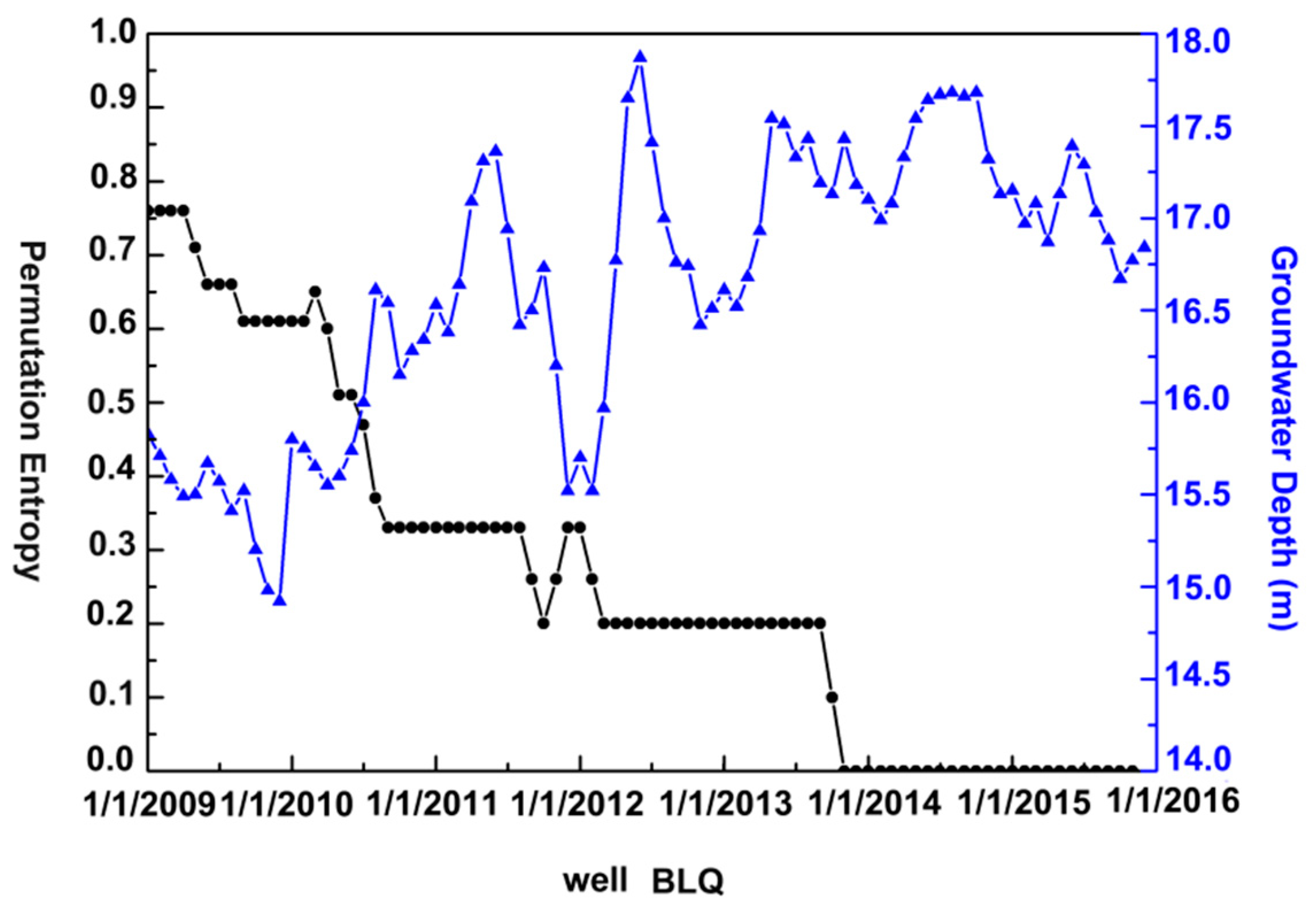

| Parameter. | Envisat ASAR | Radarsat-2 |
|---|---|---|
| Band | C | C |
| Wavelength (cm) | 5.6 | 5.5 |
| Polarization | VV | VV |
| Orbit directions | Descending | Descending |
| Track no. | 2218 | 60115 |
| Incidence angle (°) | 22.9 | 27.6 |
| Heading (°) | −164 | −168.8 |
| Spatial resolution (m) | 30 | 30 |
| No. of images | 31 | 48 |
| Data range | January 2007–August 2010 | October 2010–November 2015 |
© 2019 by the authors. Licensee MDPI, Basel, Switzerland. This article is an open access article distributed under the terms and conditions of the Creative Commons Attribution (CC BY) license (http://creativecommons.org/licenses/by/4.0/).
Share and Cite
Zuo, J.; Gong, H.; Chen, B.; Liu, K.; Zhou, C.; Ke, Y. Time-Series Evolution Patterns of Land Subsidence in the Eastern Beijing Plain, China. Remote Sens. 2019, 11, 539. https://doi.org/10.3390/rs11050539
Zuo J, Gong H, Chen B, Liu K, Zhou C, Ke Y. Time-Series Evolution Patterns of Land Subsidence in the Eastern Beijing Plain, China. Remote Sensing. 2019; 11(5):539. https://doi.org/10.3390/rs11050539
Chicago/Turabian StyleZuo, Junjie, Huili Gong, Beibei Chen, Kaisi Liu, Chaofan Zhou, and Yinghai Ke. 2019. "Time-Series Evolution Patterns of Land Subsidence in the Eastern Beijing Plain, China" Remote Sensing 11, no. 5: 539. https://doi.org/10.3390/rs11050539





